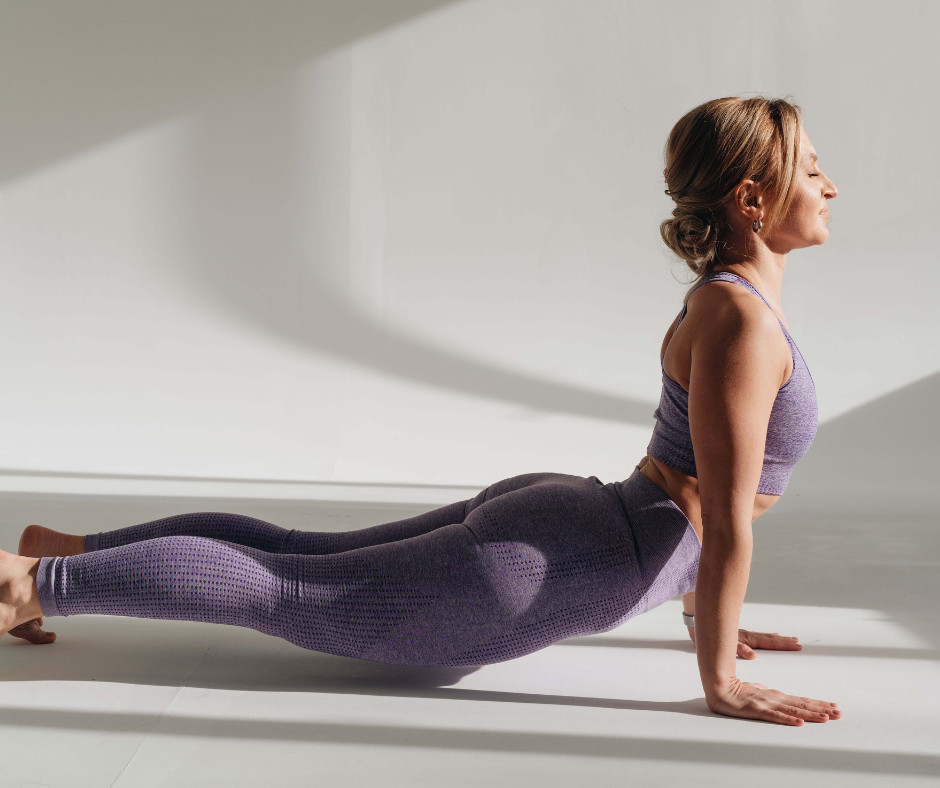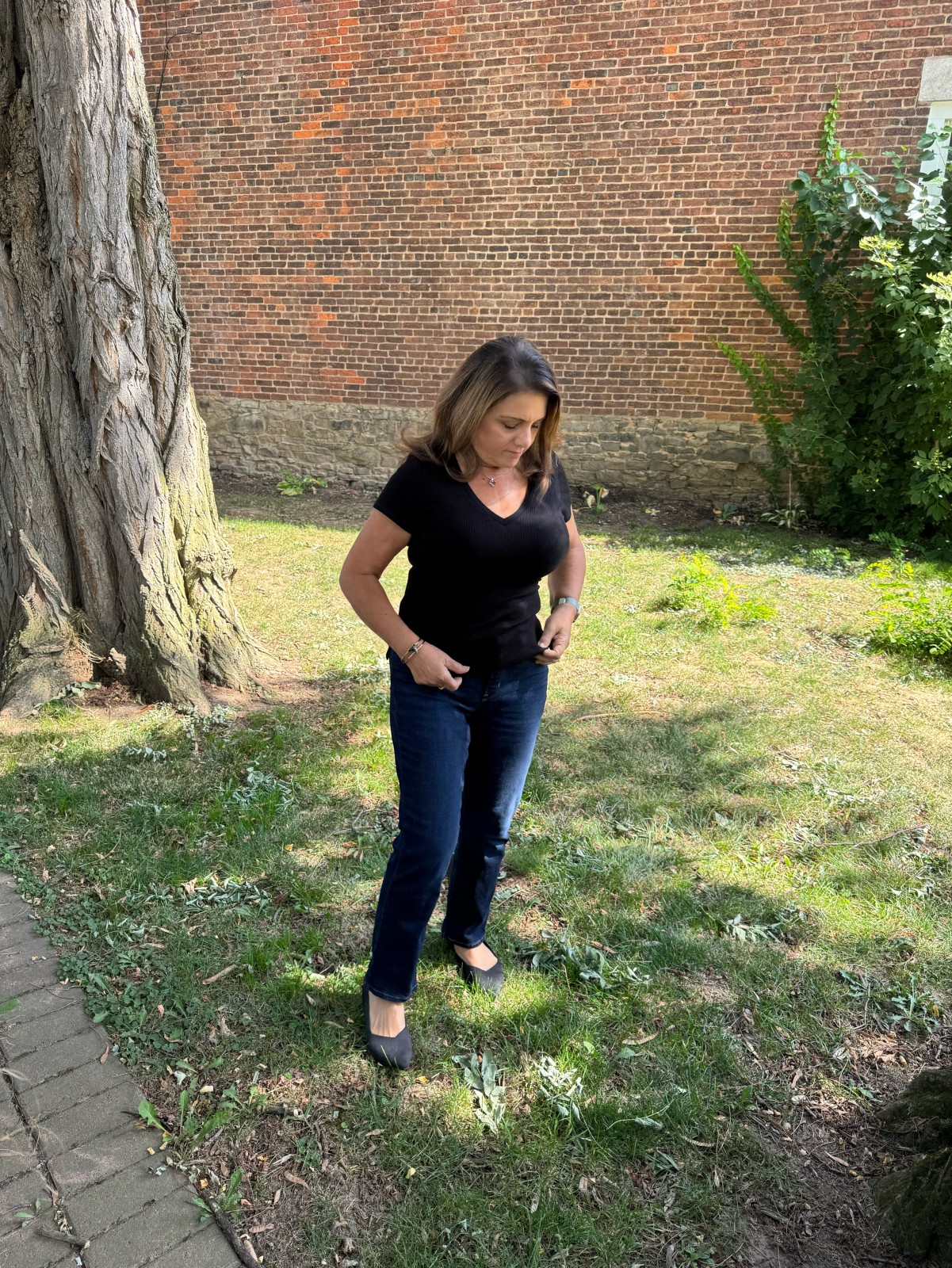
(And how to finally make your body work with you again)
The Truth: Your Body Has Changed — and That’s Okay
There was a time when losing weight was simple.
Skip dessert, walk a little more, maybe cut carbs for a week — and you’d see results.
Skip dessert, walk a little more, maybe cut carbs for a week — and you’d see results.
Then 50 arrived.
And suddenly, your body stopped responding.
And suddenly, your body stopped responding.
You’re eating better than ever, walking your steps, even tracking calories — yet the scale won’t budge. Your energy’s low, your joints ache, and you feel stuck.
You’re not doing anything wrong. Your body has simply changed — and it needs a new approach.
1️⃣ Your Hormones Aren’t the Same
Hormones run the show. Estrogen, progesterone, and testosterone all naturally decline after 40 — and that changes everything:
- Less estrogen: more belly fat storage
- Less testosterone: less muscle (which means slower metabolism)
- Fluctuating progesterone: more water retention and sleep issues
This isn’t your fault — it’s biology.
Instead of fighting your hormones, focus on supporting them through proper nutrition, quality sleep, strength training, and stress management.
Instead of fighting your hormones, focus on supporting them through proper nutrition, quality sleep, strength training, and stress management.
2️⃣ You’ve Lost Muscle — and Muscle Burns Fat
Muscle is your metabolism’s engine.
Starting around 40, we lose 3–8% of our muscle mass every decade if we’re not actively building it.
Starting around 40, we lose 3–8% of our muscle mass every decade if we’re not actively building it.
Less muscle = fewer calories burned = easier weight gain.
The fix?
- Prioritize strength training at least 2–3 times per week.
- Include protein at every meal (aim for 25–30g per serving).
- Support recovery and muscle repair through hydration, rest, and movement.
It’s not about working harder — it’s about working smarter.
3️⃣ Stress Hormones Are Running the Show
Cortisol, your main stress hormone, used to rise and fall naturally.
Now it’s stuck in “on” mode.
Now it’s stuck in “on” mode.
Between juggling family, work, finances, and health, your nervous system rarely gets a break.
When cortisol stays high, your body holds onto fat, especially around the midsection. It also disrupts sleep and increases sugar cravings.
To calm it down:
- Create a nightly wind-down routine
- Practice slow breathing or meditation
- Get outside every day — even 10 minutes helps
- Learn to rest without guilt
You can’t out-diet stress. You have to heal it.
4️⃣ Your Energy Production Has Slowed
If you feel like your “get up and go” just disappeared, it’s not in your head.
Your mitochondria — your body’s tiny energy factories — become less efficient with age.
Your mitochondria — your body’s tiny energy factories — become less efficient with age.
The result? Lower energy, slower metabolism, and less motivation.
The fix: movement, hydration, good sleep, and nutrients that support cellular repair. When your cells are fueled, everything changes — energy, mood, and metabolism.
5️⃣ Your Brain Feels Foggy
Brain fog isn’t “just getting older.”
It’s often the result of poor sleep, stress, hormone changes, or inflammation.
It’s often the result of poor sleep, stress, hormone changes, or inflammation.
You might forget words mid-sentence or feel like your mind’s running through molasses. Supporting brain health through nutrition, hydration, and rest can make a world of difference.
Clear mind → better choices → consistent habits → real results.
6️⃣ You’re Probably Dehydrated (and Don’t Even Know It)
Even if you drink water all day, your body’s ability to absorb and hold water changes as you age.
Mild dehydration can cause fatigue, hunger, headaches, and slower digestion — all things that make weight loss feel impossible.
Hydration isn’t just about water intake; it’s about electrolyte balance and cellular function. Keep it simple: sip consistently throughout the day, not all at once.
🌿 Final Thought
If you’ve been doing everything right and still not seeing results, it’s not because you’ve failed — it’s because your body needs different support than it used to.
This stage of life isn’t about dieting harder — it’s about understanding your biology and working with it.
I’ve found a solution that’s been helping me feel stronger, clearer, and more energized than I have in years.
I’m happy to share what’s been working for me.
I’m happy to share what’s been working for me.
Disclaimer: The information in this article is for educational purposes only and should not be considered medical advice. Please consult with a healthcare professional before making any changes to your diet or lifestyle.

Top Five Health Reasons Women Over 40 Should Practice Yoga
Life has a funny way of bending and stretching, much like a yoga pose. As we hit the fabulous 40s, the push and pull of daily life can make the body feel like it’s no longer our faithful ally. Yet, in the midst of life’s hectic tempo, adopting a regular yoga practice can be the gentle, yet powerful, re-alignment tool our bodies desperately need.
This article strips away the skepticism and invites women over 40 into a world of possibilities that yoga offers. Here are five compelling reasons why incorporating yoga into your daily routine can help you unlock a healthier, more vital you.
1. Strength Enhancement Beyond Resistance Training
You might think of the benefits of strength training as more pronounced in younger years. However, yoga's consistent, full-body approach to isometric exercises can significantly enhance muscular strength and endurance. Unlike the weightlifting approach which isolates muscle groups, yoga asanas engage multiple muscle groups simultaneously, fostering a more balanced approach to strength.
Women over 40 often face the challenges of diminishing bone density and muscle mass, which makes activities like yoga pivotal in maintaining overall strength. A consistent yoga practice can help counteract these natural effects of aging, ensuring you stay strong to enjoy life to the fullest.
2. Alleviate Back Pain Through Mindful Movement
Back pain can be one of the most debilitating and persistent health issues women encounter as they age. Unlike the high-impact nature of some sports and exercises, yoga is low-impact, reducing the risk of injury while gently stretching and strengthening the back and core muscle groups.
Certain yoga poses, such as Cat-Cow, Downward Dog, and Child’s Pose, can provide immediate relief from back pain. Over time, these poses help alleviate chronic back issues, making it easier to maintain an active lifestyle without the constant threat of aching.
3. Mitigating Arthritis: A Balancing Act of Mobility and Stability
Arthritis can make movement painful, yet the adage 'use it or lose it' is especially true for maintaining joint health. The practice of yoga is uniquely positioned to offer both the mobility and stability required to manage arthritis effectively.
Yoga’s focus on fluid movement combined with static poses that work on balance and joint stability can improve the flexibility and function of your joints. By strengthening the muscles surrounding these joints, you create a supportive structure that reduces the impact of arthritis symptoms.
4. Yoga and Heart Health: Finding Peace for a Healthier Heart
Stress, inflammation, and compromised cardiovascular health are all too common as we age. Yoga goes beyond physical asanas, encompassing relaxation techniques and breathing exercises that have a direct, positive impact on the heart and the body's stress response.
Incorporating a regular yoga practice into your routine can help lower blood pressure, reduce oxidative stress, and lower the heart rate. As we all know, a calm heart is a happy heart, and yoga has the tools to help you achieve that.
5. The Sleeper's Stretch: Yoga for Better Sleep
Quality sleep is the cornerstone of a healthy life. Many women in their 40s and beyond struggle with insomnia and sleep disturbances due to hormonal changes, stress, or chronic pain. Yoga’s emphasis on calm breathing, winding down, and the relaxation of the body can lead to better sleep quality.
Practicing yoga before bedtime can be an excellent way to physically and mentally prepare for sleep. Poses such as Legs-Up-the-Wall or Savasana with deep breathing exercises can signal to your mind and body that it’s time to unwind and restore for a new day.
Bringing It All Together: The Call to Gentle Action
If the idea of a yoga practice has piqued your interest, now is the perfect time to start. The key is not to overthink it but to gently engage with the practice, and your body will thank you for it. Even starting with just a few minutes of yoga a day can lead to profound changes in your well-being.
I invite you to join my community of like-minded women who have found transformation through gentle, yet purposeful, changes in their routines. By practicing healthy habits together, we support each other on the path to a more vibrant and active life.
For those interested, I have a special program tailored to women over 40. This program has been designed to lose 7-15 pounds and reduce inflammation in just 11 days, tackling one of the main precursors to age-related diseases. If you're ready to make a change, click the link below to find out more about the program.
Remember, in health, as in life, the steadfast, consistent steps are the ones that carry us the farthest.
Join my Facebook group and connect with a supportive community of women on the same wellness journey.
Discover my signature program designed specifically for women like you who are ready to make a significant transformation in their health.
To ensure you're getting the best experience in your practice, I personally recommend the yoga mat that I use for all my sessions. It's durable, comfortable, and gives the perfect amount of support and grip for any pose. You can find this yoga mat here My Recommended Yoga Mat. It's been a game-changer for my practice, and I'm confident it will enhance yours too.
Disclaimer: The information in this article is for educational purposes only and should not be considered medical advice. Please consult with a healthcare professional before making any changes to your diet or lifestyle.

Chronic inflammation can be a source of significant discomfort and is a contributing factor in a number of health conditions. However, the power of a well-curated diet can be your ally against this silent adversary. Certain foods have been scientifically recognized to possess natural anti-inflammatory properties, making them ideal not just for pain relief, but also for improving your overall health.
One of the most celebrated anti-inflammatory foods is the omega-3 rich fatty fish. Salmon, mackerel, sardines, and anchovies are an excellent source of these essential fats that can help reduce the levels of inflammatory markers in the body. Including these fish in your diet a few times a week can make a substantial difference in managing inflammation.
Leafy greens like spinach, kale, and collard greens are also potent allies. They are packed with vitamins and minerals, notably vitamin E, which may help protect the body from pro-inflammatory molecules known as cytokines. Colorful berries such as blueberries, strawberries, blackberries, and raspberries contain flavonoids — powerful antioxidants that can combat inflammation and even reduce the risk of disease.
Whole grains are another important component of an anti-inflammatory diet. Whole wheat, brown rice, quinoa, and oats are high in fiber, which has been shown to reduce levels of C-reactive protein, a marker of inflammation in the blood.
Nuts, especially almonds and walnuts, are not only satisfying and nutritious but they also boast high amounts of omega-3 fatty acids and antioxidants. A handful a day can aid in reducing inflammation and provide numerous other health benefits.
Don't forget about the spices in your kitchen when combating inflammation. Turmeric, in particular, contains a strong anti-inflammatory compound called curcumin. When combined with black pepper, which contains piperine, absorption of curcumin is significantly increased, making this spice duo a powerful component of an anti-inflammatory diet.
Extra virgin olive oil is a staple in anti-inflammatory diets, particularly the Mediterranean diet. It is rich in monounsaturated fats and polyphenols, which have been connected to reduced risk of heart disease and other inflammatory diseases.
Lastly, green tea is revered for its health benefits, with one star component being the antioxidant ECGC. It can lower the production of inflammatory cytokines and the damage they can cause to the cells.
In conclusion, while these foods can aid in reducing inflammation, it is also important to avoid or limit consumption of foods that can trigger or worsen inflammation, such as refined sugars, fried foods, and processed meats. Combining a diet rich in anti-inflammatory foods with regular exercise and a healthy lifestyle is an effective strategy for managing inflammation and enhancing your overall well-being.
Join our 'Healthy Living Beyond 40' community today, and unlock the secrets to thriving in your middle years with expert advice, supportive peers, and actionable strategies for balancing hormones and maintaining a healthy weight. Join the group here: https://bit.ly/48uQP0Z
If you're looking for an easy button on what foods cause inflammation get my free guide “Anti _Inflammatory Guide - foods to avoid, foods to enjoy!”
Oh by the way, I have a program where we lose 7-15 pounds and reduce inflammation in just 11 days. Inflammation is one of the main reasons we get age related diseases! Grab the info here: https://bit.ly/42ecgBJ
Disclaimer: The information in this article is for educational purposes only and should not be considered medical advice. Please consult with a healthcare professional before making any changes to your diet or lifestyle.
How to Achieve Natural Pain Relief Without Pharmaceuticals: A Guide to Herbal Remedies and Alternati

Natural Pain Relief: Herbal Remedies That Work
In the quest for alternatives to pharmaceuticals, many turn to herbal remedies for pain relief. This guide highlights the scientific evidence supporting certain herbs' ability to reduce pain and inflammation. It’s tailored for those interested in holistic health, pain management, and herbal remedies, presenting an overview of how these botanicals can enhance well-being without traditional medication side effects.
Pain and inflammation are complex experiences often linked, with inflammation being the body’s response to injury or infection. Medicinal plants address pain through various mechanisms, such as reducing nerve sensitivity, inhibiting inflammatory pathways, and promoting healing. Chronic pain, defined as pain lasting longer than three to six months, frequently involves inflammation, making anti-inflammatory herbs potentially beneficial for long-term relief.
Key Herbs for Pain Relief:
- Turmeric: Known for its compound curcumin, turmeric is a staple in traditional Indian medicine and has shown promise in treating arthritis-related inflammation. Curcumin reduces pain and stiffness by suppressing enzymes involved in inflammation. I use Golden Turmeric, it's 24 times more bioavailable than standard turmeric extract. Your body absorbs the same amount of curcuminoids from just 300 mg of Golden Turmeric as it does from 1,926 mg of standard turmeric.
- Ginger: A relative of turmeric, ginger is renowned for its anti-inflammatory properties and has been used for centuries to alleviate pain, including migraines. It's particularly effective for gastrointestinal inflammation and muscle pain, offering relief when applied topically.
- Boswellia: Derived from the Boswellia serrata tree resin, boswellia has been shown to reduce inflammation and manage chronic inflammatory diseases by inhibiting leukotrienes, which play a significant role in the inflammatory response. I use Frankincense
- Willow Bark: Known as the original aspirin, willow bark has been used since Hippocrates' time to relieve pain and fever. Its active ingredient, salicin, acts similarly to aspirin but is often better tolerated by those with sensitive stomachs.
Incorporating these herbs into daily life requires careful consideration. Always source herbs from reputable providers, start with small doses, and consult healthcare professionals if pregnant, nursing, or managing a chronic condition. Be aware of potential interactions with medications.
Here is the link to what I use to manage my inflammation.
Get my free guide “Anti _Inflammatory Guide - foods to avoid, foods to enjoy!”
Join our vibrant community at 'Healthy Living Beyond 40' on Facebook, where we share insights, support, and strategies for thriving in health and wellness after 40. Let's navigate the journey together!
Oh by the way, we have a program where we lose 7-15 lbs and reduce pain and inflammation in just 11 days. Grab the info here!
Disclaimer: The information in this article is for educational purposes only and should not be considered medical advice. Please consult with a healthcare professional before making any changes to your diet or lifestyle.

Can Your Blood Tell If You Have Heart Disease? A Comprehensive View for Health-Conscious Women Over 40
Navigating the intricate landscape of your body's health, especially as you cross the pivotal milestone of 40, is like deciphering a complex puzzle. If you're a health enthusiast, a woman hitting her stride in the middle of life's journey, you know that heart health must become a prominent piece in your wellness tapestry. But the route to understanding your heart's state is not a direct one, often laden with question marks and technical jargon. The cornerstone for women is knowledge—in particular, demystifying the role of blood tests in deciphering heart disease risk.
Understanding the Female Heart: Unveiling a Distinct Diagnostic Path
The conversation surrounding heart disease has traditionally centered on men, yet women face an entirely different set of challenges. There exist disparities not only in the prevalence and presentation of cardiovascular issues but also in the diagnostic tools available. Despite this, simple blood tests can offer pivotal insights.
The Role of Cholesterol
For women, a blood test to measure cholesterol—specifically total cholesterol, LDL (low-density lipoprotein, or 'bad' cholesterol), HDL (high-density lipoprotein, or 'good' cholesterol), and triglycerides—provides a foundation. However, it's essential to recognize that women's cholesterol levels seem to rise after menopause due to the decline in estrogen levels, increasing their risk of heart disease. These levels hence may hold a different risk assessment compared to those of premenopausal women, making regular monitoring imperative.
Inflammation and Heart Health
Another significant marker is C-reactive protein (CRP), an inflammation marker, which blood tests can detect. Inflammation in the arteries might be an early sign of the development of atherosclerosis, or the hardening of the arteries, a precursor to heart disease.
Lipid Ratios and Apolipoproteins
Delving deeper, measuring lipid ratios (like total cholesterol/HDL ratio) and apolipoproteins can provide a more nuanced understanding of cholesterol's role in heart health. These tests may offer a more accurate risk assessment for cardiovascular disease in women as they grow older.
Other Indicators
Blood tests may also look for evidence of anemia, a condition that is more common in women and can exacerbate heart stress, as well as thyroid levels, which if imbalanced, can affect the heart's function.
Adopting a preventive approach allows for early intervention, often before any symptoms of heart disease appear. By leveraging these "windows" into your heart health, women over 40 can tailor their lifestyle choices to promote cardiovascular wellness effectively.
The Holistic Picture: Teaming Up Blood Tests with Lifestyle Modifications
For women in their 40s and beyond, heart health is a critical component of their overall wellness. While blood tests are a key diagnostic tool, they're just one piece of the puzzle. A holistic approach involves integrating information from these tests into a broader strategy of healthy living.
Nutrition: A Defense Against Heart Disease
Your diet is one of the most influential variables. Embracing a heart-healthy diet that's high in whole grains, lean protein, and plenty of fruits and vegetables, and low in saturated and trans fats, cholesterol, and salt, can significantly lower your risk of heart disease.
Exercise: Keeping Your Heart Strong
Physical activity is another potent prescription. Regular exercise, encompassing both aerobic activities and strength training, not only helps manage weight but also strengthens the heart muscle, improves circulation, and can lower cholesterol and blood pressure.
Stress Management: A Silent, Deadly Adversary
Chronic stress can contribute to heart disease through actions like promoting overeating or influencing blood pressure. Stress management is not just about taking a day off—it's an essential part of maintaining a healthy heart.
Sleep as a Cardiac Ally
Adequate sleep is as integral to heart health as any other factor. Women, especially those navigating the menopause years, often face challenges such as hot flashes that can disrupt their sleep. Addressing these issues becomes a key component. I find that using this Side Sleeper pillow really helps me get a restful night sleep.
Adopting these lifestyle behaviors not only complements the information garnered from blood tests but also empowers women to take a proactive stance against heart disease.
Technology as an Adjunct: Apps and Trackers for Heart Health Empowerment
In the digital age, health and fitness apps, wearable technologies, and various tracking devices have become invaluable resources. For women like Helen, these tools offer a granular, personalized look at their health, potentially minimizing the surprise factor often associated with heart disease.
Fitness and Wellness Apps: Tracking Your Heart Health
Numerous apps can help in logging nutrition, monitoring physical activity, and even managing stress levels. They can also provide a snapshot of ongoing trends, enabling users to continuously refine their approach to wellness.
Wearable Devices: Real-Time Feedback
Devices such as smartwatches can track heart rate, sleep patterns, and even offer ECG readings. The real-time data they provide can help in identifying potential problems early and motivate users to stay on course with their health goals. I love the Whoop for this, it monitors everything I need and is comfortable to wear when I sleep.
Personal Health Records: The Complete Picture
Integrating the results of blood tests into personal health records can provide a comprehensive history that users can reference and share with healthcare providers. This complete picture allows for better-informed medical decisions and personalized recommendations.
By harnessing the collective power of technology and information provided by blood tests, women over 40 can truly step into the driver's seat of their heart health journey.
Joining the Community: Support Networks and Resources
As the focus on heart health intensifies, joining a supportive community can be a game-changer. Not only does it offer opportunities for education and sharing experiences, but it also fosters a sense of accountability and connectedness that is invaluable on the health and wellness path.
Local Health Groups and Gyms: A Physical Hub for Health Conversations
Participating in local health groups or engaging with fitness centers can provide an accessible point of discourse on heart health and foster an environment of mutual support among like-minded individuals.
Online Platforms and Social Media: The Digital Watercooler
With the proliferation of online platforms and social media, there's no shortage of spaces to connect with others who share an interest in heart health. These communities offer a wealth of knowledge, personal stories, and encouragement that can be inspiring and informative.
Expert Advice and Workshops: Strengthening the Knowledge Base
Seeking out workshops, webinars, and talks from healthcare professionals specializing in heart health can provide expert insights and guidance, transforming the abstract concept of 'blood tests' into actionable steps.
Moving Forward: Taking the Next Step Towards Heart Health
The journey to heart health is a personal one, marked by challenges, discoveries, and triumphs. For women over 40 determined to stay healthy and active, the path includes understanding the implications and insights offered by blood tests, integrating these into a holistic approach to wellness, leveraging technology and support systems, and continuously educating oneself.
Empowered with this multifaceted armor, women are equipped to make the choices that not only affect their heart but also resonate with the rhythm of an exuberant and meaningful life. It's not just about living longer—it's about living better.
If you're ready to embark on this journey, we extend an invitation to our community "Healthy Living for Women Beyond 40." Together, we're forging a future where heart health is a non-negotiable part of the narrative, a journey that celebrates the woman, the heart, and the life she so richly deserves. Join us, as we take that step—towards health, towards vigor, towards life.
Join us on an empowering 11-Day Jumpstart designed specifically for women over 40 looking to take a proactive step towards heart health and overall wellness. In just 11 days, you'll embark on a transformative journey that focuses on reducing inflammation—a leading cause of heart disease—while also aiming to lose 7-15 pounds. This carefully curated program combines nutrition, exercise, and stress management strategies to combat inflammation and kickstart your path to a healthier heart and body. Don't miss this opportunity to make a significant impact on your health in a short amount of time. Let's take this step together towards a vibrant, heart-healthy future."
Interested in supporting your heart health with the strategies that have worked for me? Here's the link to the products I personally use to maintain healthy heart function. These products have been instrumental in my journey towards a healthier heart. Check them out and see how they can help you on your path to heart health: https://bit.ly/49fHKKA . Whether you're looking to reduce inflammation, improve your diet, or enhance your exercise routine, these products can provide the support you need to achieve your heart health goals.
#PaidLinks
Disclaimer: The information in this article is for educational purposes only and should not be considered medical advice. Please consult with a healthcare professional before making any changes to your diet or lifestyle.











